Allies of World War II
| Allies of World War II | ||||||||||||
| United Nations | ||||||||||||
| Military alliance | ||||||||||||
| ||||||||||||
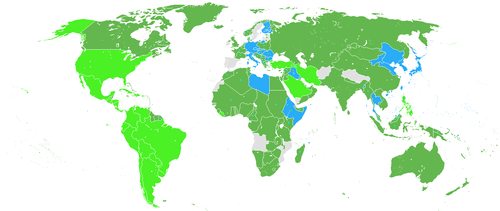
Combatant States:
| ||||||||||||
| Capital | Not specified | |||||||||||
| Political structure | Military alliance | |||||||||||
| Historical era | World War II | |||||||||||
| • | Established | 1939 | ||||||||||
| • | Disestablished | 1945 | ||||||||||
| ||||||||||||



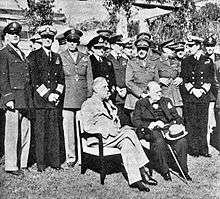
The Allies of World War II, called the United Nations from the 1 January 1942 declaration, were the countries that together opposed the Axis powers during the Second World War (1939–1945). The Allies promoted the alliance as seeking to stop German, Japanese and Italian aggression.
At the start of the war on 1 September 1939, the Allies consisted of France, Poland and the United Kingdom, and dependent states, such as the British India. Within days they were joined by the independent Dominions of the British Commonwealth: Australia, Canada, New Zealand and South Africa.[1] Poland was a minor factor after its defeat in 1939; France was a minor factor after its defeat in 1940. After first having cooperated with Germany in invading Poland whilst remaining neutral in the Allied-Axis conflict, the Soviet Union perforce joined the Allies in June 1941 after being invaded by Germany. Greece joined the Allies in 1940, after Italy's failed invasion, which triggered the intervention of Germany. The United States provided war materiel and money all along, and officially joined in December 1941 after the Japanese attack on Pearl Harbor. China had already been into a prolonged war with Japan since the Marco Polo Bridge Incident of 1937, but officially joined the Allies in 1941.
The alliance was formalised by the Declaration by United Nations, from 1 January 1942. However, the name United Nations was rarely used to describe the Allies during the war. The leaders of the "Big Three" – the UK, the Soviet Union, and the United States – controlled Allied strategy; relations between the United Kingdom and the United States were especially close. China and the Big Three were referred as a "trusteeship of the powerful",[2] then were recognized as the Allied "Big Four" in Declaration by United Nations[3] and later the "Four Policemen" .
Other key Allies included the Netherlands, Yugoslavia and Free France, although there were numerous others.
In 1945, the Allied nations became the basis of the United Nations.[4]
Origins and creation
The origins of the Allied powers stem from the Allies of World War I and cooperation of the victorious powers at the Paris Peace Conference, 1919. Germany resented signing Treaty of Versailles. The new Weimar republic's legitimacy became shaken. However, the 1920s were peaceful.
With the Stock Market Crash of 1929 and the ensuing Great Depression, political unrest in Europe soared including the rise in support of revanchist nationalists in Germany who falsy blamed the severity of the economic crisis on the Treaty of Versailles. By the early 1930s, the Nazi Party led by Adolf Hitler became the dominant revanchist movement in Germany and Hitler and the Nazis gained power in 1933. The Nazi regime demanded the immediate cancellation of the Treaty of Versailles and made claims to German-populated Austria, and German-populated territories of Czechoslovakia. The likelihood of war was high, and the question was whether it could be avoided through strategies such as appeasement.
In Asia, when Japan seized Manchuria in 1931, the League of Nations condemned it for aggression against China. Japan responded by leaving the League of Nations in March 1933. After four quiet years, the Sino-Japanese War erupted in 1937 with Japanese forces invading China. The League of Nations condemned Japan's actions and initiated sanctions on Japan. The United States, in particular, was angered at Japan and sought to support China.

In March 1939, Germany took over Czechoslovakia, violating the Munich Agreement signed six months before, and demonstrating that the appeasement policy was a failure. Britain and France decided that Hitler had no intention to uphold diplomatic agreements and responded by preparing for war. On 31 March 1939, Britain formed the Anglo-Polish military alliance in an effort to avert a German attack on the country. Also, the French had a long-standing alliance with Poland since 1921. The Western powers also sought an alliance with the Soviet Union, but Hitler ended the risk of a war with Stalin by signing the Nazi–Soviet non-aggression pact in August 1939. The agreement secretly divided the independent nations of eastern Europe between the two powers and assured adequate oil supplies for the German war machine. On 1 September 1939, Germany invaded Poland; two days later Britain and France declared war on Germany. Then, on 17 September 1939, the Soviet Union invaded Poland from the east. A Polish government-in-exile was set up and it continued to be one of the Allies, a model followed by other occupied countries. After a quiet winter, Germany in April 1940 invaded and quickly defeated Denmark, Norway, Belgium, the Netherlands and France. Britain and its Empire stood alone against Hitler and Mussolini. In June 1941, Hitler broke the non-aggression agreement with Stalin and Germany invaded the Soviet Union. In December, Japan attacked the US and Britain. The main lines of World War II had formed.
Major affiliated state combatants
During December 1941, U.S. President Franklin D. Roosevelt devised the name "United Nations" for the Allies and proposed it to British Prime Minister Winston Churchill.[5][6] He referred to the Big Three and China as a "trusteeship of the powerful", and then later the "Four Policemen".[2] The Declaration by United Nations on 1 January 1942 was the basis of the modern United Nations (UN).[7] At the Potsdam Conference of July–August 1945, Roosevelt's successor, Harry S. Truman, proposed that the foreign ministers of China, France, the Soviet Union, United Kingdom, and the United States "should draft the peace treaties and boundary settlements of Europe", which led to the creation of the Council of Foreign Ministers of the "Big Five", and soon thereafter the establishment of those states as the permanent members of the UNSC.[8]
United Kingdom




War declared
Great Britain and other members of the British Commonwealth, most known as the Dominions, declared war on Germany separately from 3 September 1939 with the UK first, all within one week of each other; these countries were Canada, Australia, New Zealand, India and the Union of South Africa.
Colonies and dependencies
In Africa
British West Africa and the British colonies in East and Southern Africa participated, mainly in the North African, East African and Middle-Eastern theatres. Two West African and one East African division served in the Burma Campaign.
Southern Rhodesia was a self-governing colony, having received responsible government in 1923. It was not a sovereign dominion. It governed itself internally and controlled its own armed forces, but had no diplomatic autonomy, and, therefore, was officially at war as soon as Britain was at war. The Southern Rhodesian colonial government issued a symbolic declaration of war nevertheless on 3 September 1939, which made no difference diplomatically, but preceded the declarations of war made by all other British dominions and colonies.[9]
In the Americas
These included: the British West Indies, British Honduras, British Guiana and the Falkland Islands.
Newfoundland was ruled as a royal colony in 1933–49, with a governor appointed by London who made the decisions.
In Asia
British India included the areas and peoples covered by later India, Bangladesh, Pakistan and (until 1937) Burma/Myanmar, which later became a separate colony.
British Malaya covers the areas of Peninsular Malaysia and Singapore, while British Borneo covers the area of Brunei, including Sabah and Sarawak of Malaysia.
Territories controlled by the Colonial Office, namely the Crown Colonies, were controlled politically by the UK and therefore also entered hostilities with Britain's declaration of war. At the outbreak of World War II, the British Indian Army numbered 205,000 men. Later during World War II, the Indian Army became the largest all-volunteer force in history, rising to over 2.5 million men in size.[10] These forces included tank, artillery and airborne forces. Indian soldiers earned 30 Victoria Crosses during the Second World War. It suffered 1,500,000 civilian casualties (more than the United Kingdom), mainly from the Bengal famine of 1943 caused by the fall of Burma to the Japanese[10] and the transfer of food to the war effort, and 87,000 military casualties (more than any Crown colony but fewer than the United Kingdom). The UK suffered 382,000 military casualties.
Protectorates included: Kuwait was a protectorate of the United Kingdom formally established in 1920. The Trucial States were protectorates in the Persian Gulf.
Palestine was a mandate dependency created in the peace agreements after World War I from former territory of the Ottoman Empire. Iraq
In Europe
The Cyprus Regiment was formed by the British Government during the Second World War and made part of the British Army structure. It was mostly Greek Cypriots volunteers and Turkish speaking Cypriot inhabitants of Cyprus but also included other Commonwealth nationalities. On a brief visit to Cyprus in 1943, Winston Churchill praised the "soldiers of the Cyprus Regiment who have served honourably on many fields from Libya to Dunkirk". About 30,000 Cypriots served in the Cyprus Regiment. The regiment was involved in action from the very start and served at Dunkirk, in the Greek Campaign (Battle of Greece) (about 600 soldiers were captured in Kalamata in 1941), North Africa (Operation Compass), France, the Middle East and Italy. Many soldiers were taken prisoner especially at the beginning of the war and were interned in various POW camps (Stalag) including Lamsdorf (Stalag VIII-B), Stalag IVC at Wistritz bei Teplitz and Stalag 4b near Most in the Czech Republic. The soldiers captured in Kalamata were transported by train to prisoner of war camps.
China

In the 1920s the Soviet Union provided military assistance to Kuomintang, or the Nationalists and helped reorganize their party along Leninist lines: a unification of party, state, and army. In exchange the Nationalists agreed to let members of the Chinese Communist Party join the Nationalists on an individual basis. However, following the nominal unification of China at the end of the Northern Expedition in 1928, Generalissimo Chiang Kai-shek purged leftists from his party and fought against the revolting Chinese Communist Party, former warlords, and other militarist factions. A fragmented China provided easy opportunities for Japan to gain territories piece by piece without engaging in total war. Following the 1931 Mukden Incident, the puppet state of Manchukuo was established. Throughout the early to mid-1930s, Chiang's anti-communist and anti-militarist campaigns continued while he fought small, incessant conflicts against Japan, usually followed by unfavorable settlements and concessions after military defeats.
In 1936 Chiang was forced to cease his anti-communist military campaigns after his kidnap and release by Zhang Xueliang, and reluctantly formed a nominal alliance with the Communists, while the Communists agreed to fight under the nominal command of the Nationalists against the Japanese. Following the Marco Polo Bridge Incident of 7 July 1937, China and Japan became embroiled in a full-scale war. The Soviet Union, wishing to keep China in the fight against Japan, supplied China with military assistance until 1941, when it signed a non-aggression pact with Japan. Continuous clashes between the Communists and Nationalists behind enemy lines cumulated in a major military conflict between these two former allies that effectively ended their cooperation against the Japanese, and China had been divided between the internationally recognized Nationalist China under the leadership of Generalissimo Chiang Kai-shek and the Communist China under the leadership of Mao Zedong until the Japanese surrendered in 1945.
Factions
Nationalists
Prior to the alliance of Germany and Italy to Japan, the Nationalist Government held close relations with both Germany and Italy. In the early 1930s, Sino-German cooperation between the Nationalist Government and Germany in military and industrial matters. Nazi Germany provided the largest proportion of Chinese arms imports and technical expertise. Relations between the Nationalist Government and Italy during the 1930s varied, however even after the Nationalist Government followed League of Nations sanctions against Italy for its invasion of Ethiopia, the international sanctions proved unsuccessful, and relations between the Fascist government in Italy and the Nationalist Government in China returned to normal shortly afterwards.[11] Up until 1936, Mussolini had provided the Nationalists with Italian military air and naval missions to help the Nationalists fight against Japanese incursions and communist insurgents.[11] Italy also held strong commercial interests and a strong commercial position in China supported by the Italian concession in Tianjin.[11] However, after 1936 the relationship between the Nationalist Government and Italy changed due to a Japanese diplomatic proposal to recognize the Italian Empire that included occupied Ethiopia within it in exchange for Italian recognition of Manchukuo, Italian Foreign Minister Galeazzo Ciano accepted this offer by Japan, and on 23 October 1936 Japan recognized the Italian Empire and Italy recognized Manchukuo, as well as discussing increasing commercial links between Italy and Japan.[12]
The Nationalist Government held close relations with the United States. The United States opposed Japan's invasion of China in 1937 that it considered an illegal violation of China's sovereignty, and offered the Nationalist Government diplomatic, economic, and military assistance during its war against Japan. In particular, the United States sought to bring the Japanese war effort to a complete halt by imposing a full embargo on all trade between the United States to Japan, Japan was dependent on the United States for 80 percent of its petroleum, resulting in an economic and military crisis for Japan that could not continue its war effort with China without access to petroleum.[13] In November 1940, American military aviator Claire Lee Chennault upon observing the dire situation in the air war between China and Japan, set out to organize a volunteer squadron of American fighter pilots to fight alongside the Chinese against Japan, known as the Flying Tigers.[14] US President Franklin D. Roosevelt accepted dispatching them to China in early 1941.[14] However, they only became operational shortly after the attack on Pearl Harbor.
The Soviet Union recognised the Republic of China but urged reconciliation with the Communist Party of China and inclusion of Communists in the government.[15] The Soviet Union also urged military and cooperation between Nationalist China and Communist China during the war.[15]
Even though the Republic of China had been fighting the longest among all the Allied powers, it only officially joined the Allies after the attack on Pearl Harbor, on 7 December 1941. China fought the Japanese Empire before joining the Allies In the Pacific War. Generalissimo Chiang Kai-shek thought Allied victory was assured with the entrance of the United States into the war, and he declared war on Germany and the other Axis nations. However, Allied aid remained low because the Burma Road was closed and the Allies suffered a series of military defeats against Japan early on in the campaign. General Sun Li-jen led the R.O.C. forces to the relief of 7,000 British forces trapped by the Japanese in the Battle of Yenangyaung. He then reconquered North Burma and re-established the land route to China by the Ledo Road. But the bulk of military aid did not arrive until the spring of 1945. More than 1.5 million Japanese troops were trapped in the China Theatre, troops that otherwise could have been deployed elsewhere if China had collapsed and made a separate peace.
Communists
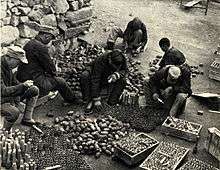

Communist China had been tacitly supported by the Soviet Union since the 1920s, though the Soviet Union diplomatically recognised the Republic of China, Joseph Stalin supported cooperation between the Nationalists and the Communists—including pressuring the Nationalist Government to grant the Communists state and military positions in the government.[15] This was continued into the 1930s that fell in line with the Soviet Union's subversion policy of popular fronts to increase communists' influence in governments.[15] The Soviet Union urged military and cooperation between Soviet China and Nationalist China during China's war against Japan.[15] Initially Mao Zedong accepted the demands of the Soviet Union and in 1938 had recognized Chiang Kai-shek as the "leader" of the "Chinese people".[16] In turn, the Soviet Union accepted Mao's tactic of "continuous guerilla warfare" in the countryside that involved a goal of extending the Communist bases, even if it would result in increased tensions with the Nationalists.[16]
After the breakdown of their cooperation with the Nationalists in 1941, the Communists prospered and grew as the war against Japan dragged on, building up their sphere of influence wherever opportunities were presented, mainly through rural mass organizations, administrative, land and tax reform measures favoring poor peasants; while the Nationalists attempted to neutralize the spread of Communist influence by military blockade and fighting the Japanese at the same time.[17]
The Communist Party's position in China was boosted further upon the Soviet invasion of Manchuria in August 1945 against the Japanese puppet state of Manchukuo and the Japanese Kwantung Army in China and Manchuria. Upon the intervention of the Soviet Union against Japan in World War II in 1945, Mao Zedong in April and May 1945 had planned to mobilize 150,000 to 250,000 soldiers from across China to work with forces of the Soviet Union in capturing Manchuria.[18]
France

War declared

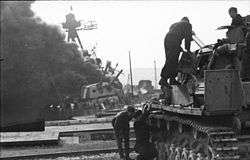
After Germany invaded Poland, France declared war on Germany on 3 September 1939.[19] In January 1940, French Prime Minister Édouard Daladier made a major speech denouncing the actions of Germany:
At the end of five months of war, one thing has become more and more clear. It is that Germany seeks to establish a domination of the world completely different from any known in world history.The domination at which the Nazis aim is not limited to the displacement of the balance of power and the imposition of the supremacy of one nation. It seeks the systematic and total destruction of those conquered by Hitler and it does not treaty with the nations which it has subdued. He destroys them. He takes from them their whole political and economic existence and seeks even to deprive them of their history and culture. He wishes only to consider them as vital space and a vacant territory over which he has every right.
The human beings who constitute these nations are for him only cattle. He orders their massacre or migration. He compels them to make room for their conquerors. He does not even take the trouble to impose any war tribute on them. He just takes all their wealth and, to prevent any revolt, he scientifically seeks the physical and moral degradation of those whose independence he has taken away.[19]
France experienced several major phases of action during World War II:
- The "Phoney War" of 1939–1940, also called drôle de guerre in France, dziwna wojna in Poland (both meaning "Strange War"), or the "Sitzkrieg" ("Sitting War") in Germany.
- The Battle of France in May–June 1940, which resulted in the defeat of the Allies, the fall of the French Third Republic, the German occupation of northern and western France, and the creation of the rump state Vichy France, which received diplomatic recognition from the Axis and most neutral countries including the United States.[20]
- The period of resistance against the occupation and Franco-French struggle for control of the colonies between the Vichy regime and the Free French, who continued the fight on the Allies' side after the Appeal of 18 June by General Charles de Gaulle, recognized by the United Kingdom as France's government-in-exile. It culminated in the Allied landings in North Africa on 11 November 1942, when Vichy ceased to exist as an independent entity after having been invaded by both the Axis and the Allies simultaneously, being thereafter only the nominal government in charge during the occupation of France. Vichy forces in French North Africa switched allegiance and merged with the Free French to participate in the campaigns of Tunisia and of Italy campaigns and the invasion of Corsica in 1943–44.
- The liberation of mainland France beginning with D-Day on 6 June 1944 and operation Overlord, and then with operation Dragoon on 15 August 1944, leading to the Liberation of Paris on 25 August 1944 by the Free French 2e Division Blindée and the installation of the Provisional Government of the French Republic in the newly liberated capital.
- Participation of the re-established provisional French Republic's First Army in the Allied advance from Paris to the Rhine and the Western Allied invasion of Germany until V-E Day on 8 May 1945.
Colonies and dependencies
In Africa
In Africa these included: French West Africa, French Equatorial Africa, the League of Nations mandates of French Cameroun and French Togo, Madagascar, French Somaliland, and the protectorates of French Tunisia and French Morocco.
French Algeria was then not a colony or dependency but a fully-fledged part of metropolitan France.
In Asia and Oceania

In Asia these included: French Polynesia, Wallis and Futuna, New Caledonia, the New Hebrides, French Indochina, French India, the mandates of Greater Lebanon and French Syria. The French government in 1936 attempted to grant independence to its mandate of Syria in the Franco-Syrian Treaty of Independence of 1936 signed by France and Syria. However, opposition to the treaty grew in France and the treaty was not ratified. Syria had become an official republic in 1930 and was largely self-governing. In 1941, a British-led invasion supported by Free French forces expelled Vichy French forces in operation Exporter.
In the Americas
In the Americas these included: Martinique, Guadeloupe, French Guiana and Saint Pierre and Miquelon.
Soviet Union

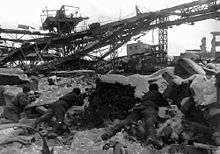

Outbreak
German invasion of the Soviet Union, Operation Barbarossa, began on 22 June 1941. General Secretary Joseph Stalin and the government of the Soviet Union described the Soviet war effort as a war being fought by the Soviet people for their survival.[21] Stalin had supported popular front movements of anti-fascists including communists and non-communists from 1935 to 1939.[22] The popular front strategy was terminated from 1939 to 1941 when the Soviet Union cooperated with Germany in 1939 in the occupation and partitioning of Poland while the Soviet Union refused to endorse either the Allies or the Axis from 1939 to 1941, as it called the Allied-Axis conflict an "imperialist war".[22] After the invasion of the Soviet Union in 1941, Stalin endorsed the Western Allies as part of a renewed popular front strategy against Germany and called for the international communist movement to make a coalition with all those who opposed the Nazis.[22]
The Soviet Union intervened against Japan and its client state in Manchuria in 1945, cooperating with the Nationalist Government of China and Nationalist Party led by Chiang Kai-shek; though also cooperating, preferring, and encouraging the Communist Party led by Mao Zedong to take effective control of Manchuria after expelling Japanese forces.[23]
History
In the lead up to the war between the Soviet Union and Germany, relations between the Soviet Union and Germany underwent several stages. Stalin studied Hitler, including reading Mein Kampf and from it knew of Hitler's desire to destroy the Soviet Union.[24] In 1933, the Soviet Union had immediate concerns with the threat of a potential German invasion of the country should Germany attempt a conquest of the Baltic states, and in December of that year, Polish-Soviet negotiations began for the issuing of a joint declaration by the two countries guaranteeing the sovereignty of the Baltic states.[25] However, Poland withdrew from the negotiations following German and Finnish objections.[25] The Soviet Union and Germany at this time competed with each other for influence in Poland.[26] The Soviet government also was concerned with the anti-Soviet sentiment in Poland and particularly Józef Piłsudski's proposed Polish federation that would include the territories of Poland, Lithuania, Belarus, and Ukraine within it that threatened the territorial integrity of the Soviet Union.[27]
On 20 August 1939, forces of the Union of Soviet Socialist Republics under General Georgy Zhukov, together with the People's Republic of Mongolia eliminated the threat of conflict in the east with a decisive victory over Japan at the Battle of Khalkhin Gol in eastern Mongolia.
On the same day, Soviet party leader Joseph Stalin received a telegram from German Chancellor Adolf Hitler, suggesting that German Foreign Minister Joachim von Ribbentrop fly to Moscow for diplomatic talks. (After receiving a lukewarm response throughout the spring and summer, Stalin abandoned attempts for a better diplomatic relationship with France and the United Kingdom.)[28]
On 23 August, Ribbentrop and Soviet Foreign Minister Vyacheslav Molotov signed the non-aggression pact including secret protocols dividing Eastern Europe into defined "spheres of influence" for the two regimes, and specifically concerning the partition of the Polish state in the event of its "territorial and political rearrangement".[29]
On 15 September 1939, Stalin concluded a durable ceasefire with Japan, to take effect the following day (it would be upgraded to a nonaggression pact in April 1941).[30] The day after that, 17 September, Soviet forces invaded Poland from the east. Although some fighting continued until 5 October, the two invading armies held at least one joint military parade on 25 September, and reinforced their non-military partnership with a German–Soviet Treaty of Friendship, Cooperation and Demarcation on 28 September.
On 30 November, the Soviet Union attacked Finland, for which it was expelled from the League of Nations. In the following year of 1940, while the world's attention was focussed upon the German invasion of France and Norway,[31] the USSR militarily[32] occupied the Baltic states[33] of Estonia, Latvia and Lithuania as well as parts of Romania.
German-Soviet treaties were brought to an end by the German surprise attack on the USSR on 22 June 1941. The Soviet Union soon entered in alliance with the United Kingdom. Following the USSR, a number of other communist, pro-Soviet or Soviet-controlled forces fought against the Axis powers during the Second World War. They were as follows: the Albanian National Liberation Front, the Chinese Red Army, the Greek National Liberation Front, the Hukbalahap, the Malayan Communist Party, the People's Republic of Mongolia, the Polish People's Army, the Tuvan People's Republic (annexed by Soviet Union in 1944),[34] the Viet Minh and the Yugoslav Partisans.
United States

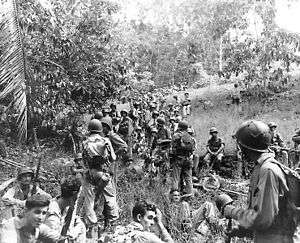
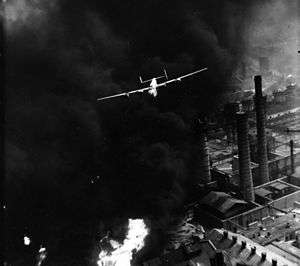

War justifications
The United States had indirectly supported Britain's war effort against Germany up to 1941 and declared its opposition to territorial aggrandizement. Materiel support to Britain was provided while the U.S. was officially neutral via the Lend Lease Act starting in 1941.
President Franklin D. Roosevelt and Prime Minister Winston Churchill in August 1941 promulgated the Atlantic Charter that pledged commitment to achieving "the final destruction of Nazi tyranny".[35] Signing the Atlantic Charter, and thereby joining the "United Nations" was the way a nation joined the Allies, and also became eligible for membership in the United Nations world body that formed in 1945.
The US strongly supported the Nationalist Government in China in its war with Japan, and provided military equipment, supplies, and volunteers to the Nationalist Government of China to assist in its war effort.[36] In December 1941 Japan opened the war with its attack on Pearl Harbor, the US declared war on Japan, and Japan's allies Germany and Italy declared war on the US, bringing the US into World War II.
History
On 8 December 1941, following the attack on Pearl Harbor, the United States Congress declared war on Japan at the request of President Franklin D. Roosevelt. This was followed by Germany and Italy declaring war on the United States on 11 December, bringing the country into the European theatre.
The US led Allied forces in the Pacific theatre against Japanese forces from 1941 to 1945. From 1943 to 1945, the US led and coordinated the Western Allies' war effort in Europe under the leadership of General Dwight Eisenhower.
The surprise attack on Pearl Harbor followed by Japan's swift attacks on Allied locations throughout the Pacific, resulted in major US losses in the first several months in the war, including losing control of the Philippines, Guam, Wake Island and several Aleutian islands including Attu and Kiska to Japanese forces. American naval forces attained some early successes against Japan. One was the bombing of Japanese industrial centres in the Doolittle Raid. Another was repelling a Japanese invasion of Port Moresby in New Guinea during the Battle of the Coral Sea.[37] A major turning point in the Pacific War was the Battle of Midway where American naval forces were outnumbered by Japanese forces that had been sent to Midway to draw out and destroy American aircraft carriers in the Pacific and seize control of Midway that would place Japanese forces in proximity to Hawaii.[38] However American forces managed to sink four of Japan's six large aircraft carriers that had initiated the attack on Pearl Harbor along with other attacks on Allied forces. Afterwards the US began an offensive against Japanese-captured positions. The Guadalcanal Campaign from 1942 to 1943 was a major contention point where American and Japanese forces struggled to gain control of Guadalcanal.
Colonies and dependencies
In the Americas and the Pacific
The United States held multiple dependencies in the Americas, such as Alaska, the Panama Canal Zone, Puerto Rico, and the U.S. Virgin Islands.
In the Pacific it held multiple island dependencies such as American Samoa, Guam, Hawaii, Midway Islands, Wake Island and others. These dependencies were directly involved in the Pacific campaign of the war.
In Asia

The Commonwealth of the Philippines was a sovereign protectorate referred to as an "associated state" of the United States. From late 1941 to 1944, the Philippines was occupied by Japanese forces, who established the Second Philippine Republic as a client state that had nominal control over the country.
Minor affiliated state combatants
Australia
Australia was a sovereign Dominion under the Australian monarchy, as per the Statute of Westminster 1931. At the start of the war Australia followed Britain's foreign policies, and accordingly declared war against Germany on 3 September 1939. Australian foreign policy became more independent after the Australian Labor Party formed government in October 1941, and Australia separately declared war against Finland, Hungary and Romania on 8 December 1941 and against Japan the next day.[39]
Belgium
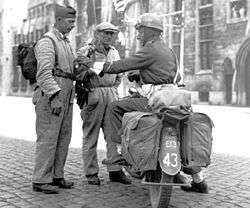
Before the war, Belgium had pursued a policy of neutrality and only became an Allied member after being invaded by Germany on 10 May 1940. During the ensuing fighting, Belgian forces fought alongside French and British forces against the invaders. While the British and French were struggling against the fast German advance elsewhere on the front, the Belgian forces were pushed into a pocket to the north. Finally, on 28 May, the King Leopold III surrendered himself and his military to the Germans, having decided the Allied cause was lost. The legal Belgian government was reformed as a government in exile in London. Belgian troops and pilots continued to fight on the Allied side as the Free Belgian Forces. Belgium itself was occupied, but a sizeable Resistance was formed and was loosely coordinated by the government in exile and other Allied powers.
British and Canadian troops arrived in Belgium in September 1944 and the capital, Brussels, was liberated on 6 September. Because of the Ardennes Offensive, the country was only fully liberated in early 1945.
Colonies and dependencies
Belgium had the colony of the Belgian Congo and the League of Nations mandate of Ruanda-Urundi. The Belgian Congo was not occupied and remained loyal to the Allies as an important economic asset while its deposits of uranium were useful to the Allied efforts to develop the atomic bomb. Troops from the Belgian Congo participated in the East African Campaign against the Italians. The colonial Force Publique also served in other theatres including Madagascar, the Middle-East, India and Burma within British units.
Brazil

Initially, Brazil maintained a position of neutrality, trading with both the Allies and the Axis Powers, while Brazilian president Getúlio Vargas's quasi-Fascist policies indicated a leaning toward the Axis powers. However, as the war progressed, trade with the Axis countries became almost impossible and the United States initiated forceful diplomatic and economic efforts to bring Brazil onto the Allied side.
At the beginning of 1942, Brazil permitted the United States to set up air bases on its territory, especially in Natal, strategically located at the easternmost corner of the South American continent, and on 28 January the country severed diplomatic relations with Germany, Japan, and Italy. After that, 36 Brazilian merchant ships were sunk by the German and Italian navies, which led the Brazilian government to declare war against Germany and Italy on 22 August 1942.
Brazil then sent a 25,700 strong Expeditionary Force to Europe that fought mainly on the Italian front, from September 1944 to May 1945. Also, the Brazilian Navy and Air Force acted in the Atlantic Ocean from the middle of 1942 until the end of the war. Brazil was the only South American country to send troops to fight in the European theatre in the Second World War.
Canada
Canada was a sovereign Dominion under the Canadian monarchy, as per the Statute of Westminster 1931. In a symbolic statement of autonomous foreign policy Prime Minister William Lyon Mackenzie King delayed parliament's vote on a declaration of war for seven days after Britain had declared war. Canada was the last member of the Commonwealth to declare war on Germany on 10 September 1939.[40]
Cuba
Because of Cuba's geographical position at the entrance of the Gulf of Mexico, Havana's role as the principal trading port in the West Indies, and the country's natural resources, Cuba was an important participant in the American Theater of World War II, and subsequently one of the greatest beneficiaries of the United States' Lend-Lease program. Cuba declared war on the Axis powers in December 1941[41] , making it one of the first Latin American countries to enter the conflict, and by the war's end in 1945 its military had developed a reputation as being the most efficient and cooperative of all the Caribbean nations.[42] On 15 May 1943, the Cuban patrol boat CS-13 sank the German submarine U-176.[43][44]
Czechoslovakia
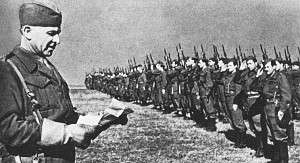
Czechoslovakia along with the United Kingdom and France attempted to resolve German irredentist claims to the Sudetenland region in 1938 with the Munich Agreement, however in March 1939, Czechoslovakia was invaded by Germany and partitioned between Germany, Hungary, Poland, and a German client state of Slovakia. The Czechoslovak government-in-exile joined the Allies, the occupation and partition of Czechoslovakia amongst the Axis powers was not accepted by the Allied powers. Czechoslovakian military units took part in the war.
Greece
Greece was invaded by Italy on 28 October 1940 and subsequently joined the Allies. The Greek Army managed to stop the Italian offensive from Italy's protectorate of Albania, and Greek forces pushed Italian forces back into Albania. However, after the German invasion of Greece in April 1941, German forces managed to occupy mainland Greece and, a month later, the island of Crete. The Greek government went into exile, while the country was placed under a puppet government and divided into occupation zones run by Italy, Germany and Bulgaria. From 1942, a strong Resistance movement appeared, chiefly in the mountainous interior, where it established a "Free Greece" by mid-1943. Following the Italian capitulation in September 1943, the Italian zone was taken over by the Germans. Axis forces left mainland Greece in October 1944, although some Aegean islands, notably Crete, remained under German occupation until the end of the war.
Luxembourg
Free Luxembourgish Forces and the Government in Exile

Before the war, Luxembourg had pursued a policy of neutrality and only became an Allied member after being invaded by Germany on 10 May 1940. The Government in Exile fled, winding up in England. It made Luxembourgish language broadcasts to the occupied country on BBC radio.[45] In 1944, the government in exile signed a treaty with the Belgian and Dutch governments, creating the Benelux Economic Union and also signed into the Bretton Woods system.
Mexico
Mexico declared war on Germany in 1942 after German submarines attacked the Mexican oil tankers Potrero del Llano and Faja de Oro that were transporting crude oil to the United States. These attacks prompted President Manuel Ávila Camacho to declare war on the Axis powers.
Mexico formed Escuadrón 201 fighter squadron as part of the Fuerza Aérea Expedicionaria Mexicana (FAEM—"Mexican Expeditionary Air Force"). The squadron was attached to the 58th Fighter Group of the United States Army Air Forces and carried out tactical air support missions during the liberation of the main Philippine island of Luzon in the summer of 1945.[46]
Some 300,000 Mexican citizens went to the United States to work on farms and factories. Some 15,000 US nationals of Mexican origin and Mexican residents in the US enrolled in the US Armed Forces and fought in various fronts around the world.[47]
Netherlands
The Netherlands became an Allied member after being invaded on 10 May 1940 by Germany. During the ensuing campaign, the Netherlands were defeated and occupied by Germany. The Netherlands was liberated by Canadian, British, American and other allied forces during the campaigns of 1944 and 1945. The Princess Irene Brigade, formed from escapees from the German invasion, took part in several actions in 1944 in Arromanches and in 1945 in the Netherlands. Navy vessels saw action in the British Channel, the North Sea and the Mediterranean, generally as part of Royal Navy units. Dutch airmen flying British aircraft participated in the air war over Germany.
Colonies and dependencies
The Dutch East Indies (modern-day Indonesia) was the principal Dutch colony in Asia, and was attacked by Japan in 1942. During the Dutch East Indies Campaign, the Netherlands played a significant role in the Allied effort to halt the Japanese advance as part of the American-British-Dutch-Australian (ABDA) Command. The ABDA fleet finally encountered the Japanese surface fleet at the Battle of Java Sea, at which Doorman gave the order to engage. During the ensuing battle the ABDA fleet suffered heavy losses, and was mostly destroyed after several naval battles around Java; the ABDA Command was later dissolved. The Japanese finally occupied the Dutch East Indies in February–March 1942. Dutch troops, aircraft and escaped ships continued to fight on the Allied side and also mounted a guerrilla campaign in Timor.
New Zealand
New Zealand was a sovereign Dominion under the New Zealand monarchy, as per the Statue of Westminster 1931. It quickly entered World War II, officially declaring war on Germany on 3 September 1939, just hours after Britain.[48] Unlike Australia, which had felt obligated to declare war, as it also had not ratified the Statute of Westminster, New Zealand did so as a sign of allegiance to Britain, and in recognition of Britain's abandonment of its former appeasement policy, which New Zealand had long opposed. This led to then Prime Minister Michael Joseph Savage declaring two days later:
With gratitude for the past and confidence in the future we range ourselves without fear beside Britain. Where she goes, we go; where she stands, we stand. We are only a small and young nation, but we march with a union of hearts and souls to a common destiny.[49]
Norway

Because of its strategic location for control of the sea lanes in the North Sea and the Atlantic, both the Allies and Germany worried about the other side gaining control of the neutral country. Germany ultimately struck first with operation Weserübung on 9 April 1940, resulting in the two-month-long Norwegian Campaign, which ended in a German victory and their war-long occupation of Norway.
Units of the Norwegian Armed Forces evacuated from Norway or raised abroad continued participating in the war from exile.
The Norwegian merchant fleet, then the fourth largest in the world, was organized into Nortraship to support the Allied cause. Nortraship was the world's largest shipping company, and at its height operated more than 1000 ships.
Poland

The invasion of Poland on 1 September 1939, started the war in Europe, and the United Kingdom and France declared war on Germany on 3 September. Poland fielded the third biggest army[50] among the European Allies, after the Soviet Union and United Kingdom, but before France. The country never officially surrendered to the Third Reich, nor to the Soviet Union, primarily because neither of the totalitarian powers requested an official surrender, and continued the war effort under the Polish government in exile. However, the Soviet Union unilaterally considered the flight to Romania of President Ignacy Mościcki and Marshal Edward Rydz-Śmigły on 17 September as an evidence of debellatio causing the extinction of Polish State, and consequently declared itself allowed to invade (according to Soviet position: "to protect") Eastern Poland starting from the same day.[51] It must be noted that the Red Army had invaded the Second Polish Republic several hours before Polish president fled to Romania. The Soviets invaded on 17 September at 3 a.m.,l [52] while president Mościcki crossed the Polish-Romanian border at 21:45 on the same day.[53] The Polish military continued to fight, and the last major battle of the war, the battle of Kock, ended at 1 a.m. on 6 October 1939 with the Independent Operational Group "Polesie," a field army, surrendering due to lack of ammunition.
.jpg)
Polish soldiers fought under their own flag but under the command of the British military. They were major contributors to the allies in the theatre of war west of Germany and in the theatre of war east of Germany, with the Soviet Union. The Polish armed forces in the West created after the fall of Poland played minor roles in the Battle of France, and important ones in the Italian and North African Campaigns.[54] The Polish People's Army took part in the Battle of Berlin, the closing battle of the European theater of war. They occupied the city alongside the Soviet Red Army.
Home Army, the largest underground force in Europe, and other resistance organizations in occupied Poland provided intelligence that enabled successful operations later in the war and led to uncovering of Nazi war crimes (i.e., death camps) to the Western Allies. Notable Polish units fought in every campaign in North Africa and Europe (outside the Balkans). The Soviet Union recognized the London-based government at first. But it broke diplomatic relations after the Katyn massacre of Polish nationals was revealed. In 1943, the Soviet Union organized the Polish People's Army under Zygmunt Berling, around which it constructed the post-war successor state People's Republic of Poland.
South Africa
South Africa was a sovereign Dominion under the South African monarchy, as per the Statue of Westminster 1931. South Africa held authority over the mandate of South-West Africa.
Yugoslavia
Yugoslavia entered the war on the Allied side after the invasion of Axis powers on 6 April 1941. Royal Yugoslav Army was thoroughly defeated in less than two weeks and the country was occupied. The Italian-backed Croatian fascist leader Ante Pavelić declared the Independent State of Croatia before the invasion was over. King Peter II and much of the Yugoslavian government had left the country. In the United Kingdom, they joined numerous other governments in exile from Nazi-occupied Europe. Beginning with the uprising in Herzegovina in June 1941, there was continuous anti-Axis resistance in Yugoslavia until the end of the war.
Resistance Factions
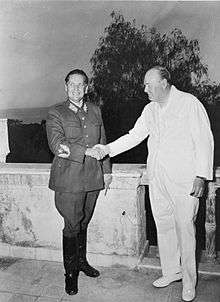
Before the end of 1941, the anti-Axis resistance movement split between the royalist Chetniks and the communist Yugoslav Partisans of Josip Broz Tito who fought both against each other during the war and against the occupying forces. The Yugoslav Partisans managed to put up considerable resistance to the Axis occupation, forming various liberated territories during the war. In August 1943, there were over 30 Axis divisions on the territory of Yugoslavia, not including the forces of the Croatian puppet state and other quisling formations.[55] In 1944, the leading Allied powers persuaded Tito's Yugoslav Partisans and the royalist Yugoslav government led by Prime Minister Ivan Šubašić to sign the Treaty of Vis that created Democratic Federal Yugoslavia.
Partisans
The Partisans were a major Yugoslav resistance movement against the Axis occupation and partition of Yugoslavia. Initially the Partisans were in rivalry with the Chetniks over control of the resistance movement. However, the Partisans were recognized by both the Eastern and Western Allies as the primary resistance movement in 1943. After that, their strength increased rapidly, from 100,000 at the beginning of 1943 to over 648,000 in September 1944. In 1945 they were transformed into Yugoslav army, organized in 4 field armies with 800,000[56] fighters.
Chetniks

The Chetniks, the short name given to the movement titled the Yugoslav Army of the Fatherland, were initially a major Allied Yugoslav resistance movement. However, due to their royalist and anti-communist views, Chetniks were considered to have begun collaborating with the Axis as a tactical move to focus on destroying their Partisan rivals. The Chetniks presented themselves as a Yugoslav movement, but were primarily a Serb movement. They reached their peak in 1943 with 93,000 fighters.[57] Their major contribution was Operation Halyard in 1944. In collaboration with the OSS, 413 Allied airmen shot down over Yugoslavia were rescued and evacuated.
Client states
British
Egypt
The Kingdom of Egypt was nominally an independent state since 1922 but effectively remained in a British sphere of influence with the British Mediterranean fleet being stationed in Alexandria and British army forces being stationed in the Suez Canal zone. Egypt faced an Axis campaign led by Italian and German forces during the war. Frustration by the UK over Egypt's King Farouk's rule resulted in the Abdeen Palace Incident of 1942 where British army forces surrounded the Abdeen palace, a residence of King Farouk, demanding a new government be established, that nearly forced the abdication of Farouk until he submitted to British demands.
British Raj (India)
At the outbreak of World War II, the Indian army numbered 205,000 men. Later during World War II the Indian Army became the largest all-volunteer force in history, rising to over 2.5 million men in size.[10] These forces included tank, artillery and airborne forces. Indian soldiers earned 30 Victoria Crosses during the Second World War. It suffered 1,500,000 civilian casualties (more than the United Kingdom), mainly from the Bengal famine of 1943 caused by the fall of Burma to the Japanese[10] and the transfer of food to the war effort, and 87,000 military casualties (more than any Crown colony but fewer than the United Kingdom). The UK suffered 382,000 military casualties.
Iraq
Iran
Soviet
Bulgaria
After a period of neutrality, Bulgaria joined the Axis powers from 1941 to 1944. The Orthodox church and others convinced King Boris to not allow the Bulgarian Jews to be exported to concentration camps. The king died shortly afterwards, suspected of being poisoned after a visit to Germany. Bulgaria abandoned the Axis and joined the Allies when the Soviet Union invaded, offering no resistance to the incoming forces. In the 1947 peace treaties, Bulgaria gained a small area near the Black Sea from Romania, making it the only former German ally to gain territory from WWII.
Mongolia
Mongolia fought against Japan during Battles of Khalkhin Gol in 1939 and the Soviet–Japanese War in August 1945 to protect its independence and to liberate Southern Mongolia from Japan and China. Mongolia had been a Soviet sphere of influence since the 1920s.
Poland (Gomułka regime)
By 1944, Poland entered the Soviet sphere of influence with Władysław Gomułka forming a communist government. Polish forces fought alongside Soviet forces against Germany.
Romania
Romania had initially been a member of the Axis powers but switched allegiance upon facing invasion by the Soviet Union. In a radio broadcast to the Romanian people and army on the night of 23 August 1944 King Michael issued a cease-fire,[58] proclaimed Romania's loyalty to the Allies, announced the acceptance of an armistice (to be signed on 12 September)[59] offered by Great Britain, the United States, and the USSR, and declared war on Germany.[60] The coup accelerated the Red Army's advance into Romania, but did not avert a rapid Soviet occupation and capture of about 130,000 Romanian soldiers, who were transported to the Soviet Union where many perished in prison camps. The armistice was signed three weeks later on 12 September 1944, on terms virtually dictated by the Soviet Union.[58] Under the terms of the armistice, Romania announced its unconditional surrender[61] to the USSR and was placed under occupation of the Allied forces with the Soviet Union as their representative, in control of media, communication, post, and civil administration behind the front.[58]
Tannu Tuva
Tannu Tuva was a partially recognized state founded from the former Tuvan protectorate of Imperial Russia. It was a client state of the Soviet Union and was annexed into the Soviet Union in 1944.
Co-belligerent state combatants
Italy

Italy initially had been a leading member of the Axis powers, however after facing multiple military losses including the loss of all of Italy's colonies to advancing Allied forces, Duce Benito Mussolini was deposed and arrested in July 1943 by order of King Victor Emmanuel III of Italy in co-operation with members of the Grand Council of Fascism who viewed Mussolini as having led Italy to ruin by allying with Germany in the war. Victor Emmanuel III dismantled the remaining apparatus of the Fascist regime and appointed Field Marshal Pietro Badoglio as Prime Minister of Italy. On 8 September 1943, Italy signed the Armistice of Cassibile with the Allies, ending Italy's war with the Allies and ending Italy's participation with the Axis powers. Expecting immediate German retaliation, Victor Emmanuel III and the Italian government relocated to southern Italy under Allied control. Germany viewed the Italian government's actions as an act of betrayal, and German forces immediately occupied all Italian territories outside of Allied control,[62] in some cases even massacring Italian troops.
Italy became a co-belligerent of the Allies, and the Italian Co-Belligerent Army was created to fight against the German occupation of Northern Italy, where German paratroopers rescued Mussolini from arrest and he was placed in charge of a German puppet state known as the Italian Social Republic (RSI). Italy descended into civil war until the end of hostilities after his deposition and arrest, with Fascists loyal to him allying with German forces and helping them against the Italian armistice government and partisans.[63]
Associated power
Albania
Albania was recognized as an "Associated Power" at the 1946 Paris conference [64] and officially signed the treaty ending WWII between the "Allied and Associated Powers" and Italy in Paris, on 10 February 1947.[65][66]
United Nations
Declaration by United Nations
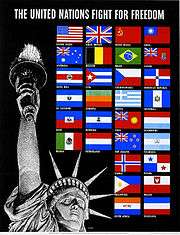
The alliance was formalised in the Declaration by United Nations on 1 January 1942. There were 26 signatories:
Alliance growing

The United Nations began growing immediately after their formation. In 1942, Mexico, the Philippines and Ethiopia adhered to the declaration. The African nation had been restored in its independence by British forces after the Italian defeat on Amba Alagi in 1941, while the Philippines, still dependent on Washington but granted international diplomatic recognition, was allowed to join on 10 June despite their occupation by Japan.
During 1943, the Declaration was signed by Iraq, Iran, Brazil, Bolivia and Colombia. A Tripartite Treaty of Alliance with Britain and USSR formalised Iran's assistance to the Allies.[67] In Rio de Janeiro, Brazilian dictator Getúlio Vargas was considered near to fascist ideas, but realistically joined the United Nations after their evident successes.
In 1944, Liberia and France signed. The French situation was very confused. Free French forces were recognized only by Britain, while the United States considered Vichy France to be the legal government of the country until Operation Overlord, while also preparing US occupation francs. Winston Churchill urged Roosevelt to restore France to its status of a major Power after the liberation of Paris in August 1944; the Prime Minister feared that after the war, Britain could remain the sole great Power in Europe facing the Communist threat, as it was in 1940 and 1941 against Nazism.
During the early part of 1945, Peru, Chile, Paraguay, Venezuela, Uruguay, Turkey, Egypt, Saudi Arabia, Lebanon, Syria (these latter two French colonies had been declared independent nations by British occupation troops, despite big protests by Pétain before, and De Gaulle after) and Ecuador became signatories. Ukraine and Belarus, which were not independent nations but parts of the Soviet Union, were accepted as members of the United Nations as way to provide greater influence to Stalin, who had only Yugoslavia as a communist partner in the alliance.
Charter of the United Nations
.svg.png)
The Charter of the United Nations was agreed to during the war at the United Nations Conference on International Organization, held between April and July 1945. The Charter was signed by 50 nations on 26 June (Poland had its place reserved and later became the 51st "original" signatory), and was formally ratified shortly after the war on 24 October 1945. In 1944, the United Nations was formulated and negotiated among the delegations from the Soviet Union, the United Kingdom, the United States and China at the Dumbarton Oaks Conference [68][69] where the formation and the permanent seats (for the "Big Five", China, France, the UK, USA and USSR) of the United Nations Security Council were decided. The Security Council met for the first time in the immediate aftermath of war on 17 January 1946.[70]
These are the original 51 signatories (UNSC permanent members are asterisked):
Timeline of nations entering war on the Axis Powers
The following list denotes dates on which nations declared war on Axis powers, or on which an Axis power declared war on them. Nepal was formally independent. Indian Empire had a status less independent than the Dominions.[71]

1939
-
 Poland: 1 September 1939[72]
Poland: 1 September 1939[72] -
 France: 3 September 1939[73] — Philippe Pétain's government formally capitulated on 22 June 1940 and the Vichy regime was later an Axis supporter. The Provisional Government of the French Republic was officially recognized by the Allies as the legitimate government of France on 23 October 1944.[74] Pétain's demand of surrender in 1940 was also legally nullified, as was the Vichy regime as a whole.[75]
France: 3 September 1939[73] — Philippe Pétain's government formally capitulated on 22 June 1940 and the Vichy regime was later an Axis supporter. The Provisional Government of the French Republic was officially recognized by the Allies as the legitimate government of France on 23 October 1944.[74] Pétain's demand of surrender in 1940 was also legally nullified, as was the Vichy regime as a whole.[75] -
 United Kingdom: 3 September 1939[73]
United Kingdom: 3 September 1939[73]
-
 Australia: 3 September 1939[76][78]
Australia: 3 September 1939[76][78] -
 New Zealand: 3 September 1939[76][79]
New Zealand: 3 September 1939[76][79] -
.svg.png) Union of South Africa: 6 September 1939[80]
Union of South Africa: 6 September 1939[80] -
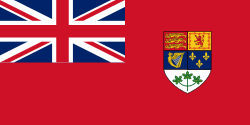 Canada: 10 September 1939[80]
Canada: 10 September 1939[80] -
 Nepal: 4 September 1939[81] sixteen battalions of the Royal Nepalese Army fought Japan on the Burmese front. In addition, many Nepali citizens fought from British Indian army as Gurkha regiment.
Nepal: 4 September 1939[81] sixteen battalions of the Royal Nepalese Army fought Japan on the Burmese front. In addition, many Nepali citizens fought from British Indian army as Gurkha regiment.
1940
-
 Norway: 8 April 1940[80]
Norway: 8 April 1940[80] -
 Belgium: 10 May 1940
Belgium: 10 May 1940 -
 Luxembourg: 10 May 1940
Luxembourg: 10 May 1940 -
 Netherlands: 10 May 1940
Netherlands: 10 May 1940 -
.svg.png) Greece: 28 October 1940
Greece: 28 October 1940
1941
-
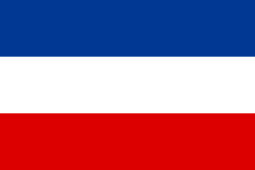 Yugoslavia: 6 April 1941 — Formally member of Axis from 25 March to 6 April 1941.
Yugoslavia: 6 April 1941 — Formally member of Axis from 25 March to 6 April 1941. -
.svg.png) Soviet Union: 22 June 1941; Despite membership of the Soviet Union, Ukraine and Belarus were recognized as separate fighting States by the United Kingdom and the United States at the end of the war.
Soviet Union: 22 June 1941; Despite membership of the Soviet Union, Ukraine and Belarus were recognized as separate fighting States by the United Kingdom and the United States at the end of the war. -
 Vietnam: 7 December 1941. Vietnam
Vietnam: 7 December 1941. Vietnam -
.svg.png) Mongolia: 8 December 1941. Mongolia declared war on Germany.
Mongolia: 8 December 1941. Mongolia declared war on Germany. -
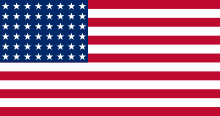 United States of America: 8 December 1941[82]
United States of America: 8 December 1941[82]
-
.svg.png) Commonwealth of the Philippines: 8 December 1941[83]
Commonwealth of the Philippines: 8 December 1941[83]
-
-
 Panama: 7 December 1941
Panama: 7 December 1941 -
 Costa Rica: 8 December 1941[80]
Costa Rica: 8 December 1941[80] -
 Dominican Republic: 8 December 1941[80]
Dominican Republic: 8 December 1941[80] -
 El Salvador: 8 December 1941[80]
El Salvador: 8 December 1941[80] -
.svg.png) Haiti: 8 December 1941[80]
Haiti: 8 December 1941[80] -
 Honduras: 8 December 1941[80]
Honduras: 8 December 1941[80] -
 Nicaragua: 8 December 1941[80]
Nicaragua: 8 December 1941[80] -
 China: 9 December 1941[80] (At war with the Empire of Japan since 1937)
China: 9 December 1941[80] (At war with the Empire of Japan since 1937) -
 Cuba: 9 December 1941[80]
Cuba: 9 December 1941[80] -
 Guatemala: 9 December 1941[80]
Guatemala: 9 December 1941[80] -
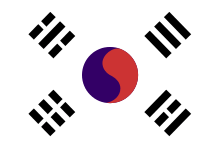 Korea(government in exile): 11 December 1941[84]
Korea(government in exile): 11 December 1941[84] -
 Czechoslovakia (government-in-exile): 16 December 1941[80][85]
Czechoslovakia (government-in-exile): 16 December 1941[80][85]
1942
1943
1944
-
 Liberia: 27 January 1944[80]
Liberia: 27 January 1944[80] -
.svg.png) Peru: 12 February 1944
Peru: 12 February 1944 -
 Romania: 25 August 1944[80] — former Axis power.
Romania: 25 August 1944[80] — former Axis power. -
 Bulgaria: 8 September 1944[86] — former Axis power.
Bulgaria: 8 September 1944[86] — former Axis power.
1945
-
.svg.png) Hungary: 20 January 1945[80] — former Axis power.
Hungary: 20 January 1945[80] — former Axis power. -
 Ecuador: 2 February 1945
Ecuador: 2 February 1945 -
.svg.png) Paraguay: 7 February 1945[80]
Paraguay: 7 February 1945[80] -
 Uruguay: 15 February 1945
Uruguay: 15 February 1945 -
.svg.png) Venezuela: 15 February 1945
Venezuela: 15 February 1945 -
 Turkey: 23 February 1945[80]
Turkey: 23 February 1945[80] -
.svg.png) Egypt: 24 February 1945[80]
Egypt: 24 February 1945[80] -
.svg.png) Syria: 26 February 1945[80]
Syria: 26 February 1945[80] -
 Lebanon: 27 February 1945[80]
Lebanon: 27 February 1945[80] -
.svg.png) Saudi Arabia: 1 March 1945[80]
Saudi Arabia: 1 March 1945[80] -
 Finland: 3 March 1945[80] — former co-belligerent of Germany in the Continuation War. On 3 March 1945, Finland retroactively declared war on Germany from 15 September 1944.
Finland: 3 March 1945[80] — former co-belligerent of Germany in the Continuation War. On 3 March 1945, Finland retroactively declared war on Germany from 15 September 1944. -
 Argentina: 27 March 1945 [87]
Argentina: 27 March 1945 [87] -
 Chile: 11 April 1945 (only declared war on Japan)[80]
Chile: 11 April 1945 (only declared war on Japan)[80] -
 Mongolia: August 1945 declared war on Japan
Mongolia: August 1945 declared war on Japan
See also
- Allies of World War I
- Diplomatic history of World War II
- Free World (World War II)
- Military production during World War II
- Neutral powers during World War II
- Participants in World War II
Footnotes
- ↑ Davies 2006, pp 150–151.
- 1 2 Doenecke, Justus D.; Stoler, Mark A. (2005). Debating Franklin D. Roosevelt's foreign policies, 1933–1945. Rowman & Littlefield.
- ↑ Hoopes, Townsend, and Douglas Brinkley. FDR and the Creation of the U.N. (Yale University Press, 1997)
- ↑ Ian C. B. Dear and Michael Foot, eds. The Oxford Companion to World War II (2005), pp 29, 1176
- ↑ Ward, Geoffrey C.; Burns, Ken (2014). "Nothing to Conceal". The Roosevelts: An Intimate History. Knopf Doubleday Publishing Group. ISBN 0385353065.
- ↑ "United Nations". Wordorigins.org. 3 February 2007. Retrieved 28 March 2016.
- ↑ Douglas Brinkley, FDR & the Making of the U.N.
- ↑ Churchill, Winston S. (1981) [1953]. The Second World War, Volume VI: Triumph and Tragedy. Houghton-Mifflin Company. p. 561.
- ↑ Wood, J R T (June 2005). So Far And No Further! Rhodesia's Bid For Independence During the Retreat From Empire 1959–1965. Victoria, British Columbia: Trafford Publishing. pp. 8–9. ISBN 978-1-4120-4952-8.
- 1 2 Gordon, Leonard A., Review of Prosperity and Misery in Modern Bengal: The Famine of 1943–1944 by Greenough, Paul R., The American Historical Review, Vol. 88, No. 4 (Oct. 1983), p. 1051 JSTOR 1874145
- 1 2 3 G. Bruce Strang. On the fiery march: Mussolini prepares for war. Westport, Connecticut, USA: Greenwood Publishing Group, Inc., 2003. Pp. 58–59.
- ↑ G. Bruce Strang. On the fiery march: Mussolini prepares for war. Westport, Connecticut, USA: Greenwood Publishing Group, Inc., 2003. Pp. 59–60.
- ↑ Euan Graham. Japan's sea lane security, 1940–2004: a matter of life and death? Oxon, England, UK; New York, New York, USA: Routledge, 2006. Pp. 77.
- 1 2 Guo wu yuan. Xin wen ban gong shi. Col. C.L. Chennault and Flying Tigers. English translation. State Council Information Office of the People's Republic of China. Pp. 16.
- 1 2 3 4 5 Frederic J. Fleron, Erik P. Hoffmann, Robbin Frederick Laird. Soviet Foreign Policy: Classic and Contemporary Issues. Third paperback edition. New Brunswick, New Jersey, USA: Transaction Publishers, 2009. Pp. 236.
- 1 2 Dieter Heinzig. The Soviet Union and communist China, 1945–1950: the arduous road to the alliance. M.E. Sharpe, 2004. Pp. 9.
- ↑ "Crisis". Time. 13 November 1944.
- ↑ Dieter Heinzig. The Soviet Union and communist China, 1945–1950: the arduous road to the alliance. M.E. Sharpe, 2004. Pp. 79.
- 1 2 Speeches that Reshaped the World.
- ↑ "When the US wanted to take over France‑Le Monde diplomatique‑English edition". Le Monde diplomatique. May 2003. Retrieved 10 December 2010.
- ↑ Helen Rapport. Joseph Stalin: A Biographical Companion. Santa Barbara, California, USA: ABC-CLIO, 1999. P. 104.
- 1 2 3 Paul Bushkovitch. A Concise History of Russia. Cambridge, England, UK; New York, New York, USA: Cambridge University Press, 2012. P. 390–391.
- ↑ The Soviet Union and Communist China, 1945–1950: The Road to Alliance. P. 78.
- ↑ Kees Boterbloem. A History of Russia and Its Empire: From Mikhail Romanov to Vladimir Putin. P235.
- 1 2 David L. Ransel, Bozena Shallcross. Polish Encounters, Russian Identity. Indiana University Press, 2005. P184.
- ↑ Jan Karski. The Great Powers and Poland: From Versailles to Yalta. Rowman & Littlefield, 2014. P197.
- ↑ David L. Ransel, Bozena Shallcross. Polish Encounters, Russian Identity. Indiana University Press, 2005. P184.
- ↑ Overy 1997, pp 41, 43–7.
- ↑ Davies 2006, pp 148–51.
- ↑ Davies 2006, pp 16, 154.
- ↑ Khudoley, Konstantin K. (2009). "The Baltic factor". In Hiden, John. The Baltic question during the Cold War. Vahur Made, David J. Smith. Psychology Press. p. 57. ISBN 978-0-415-37100-1.
- ↑ Geoffrey, Roberts (2004). "Ideology, calculation, and improvisation. Sphere of influence and Soviet foreign policy 1939–1945". In Martel, Gordon. The World War Two reader. Routledge. p. 88. ISBN 978-0-415-22402-4.
- ↑ Roberts, Geoffrey (1995). "Soviet policy and the Baltic States, 1939–1940 a reappraisal". Diplomacy & Statecraft. Francis & Taylor. 6 (3): 672–700. doi:10.1080/09592299508405982.
- ↑ Toomas Alatalu. Tuva. A State Reawakens. Soviet Studies, Vol. 44, No. 5 (1992), pp. 881–895
- ↑ Frank Freidel (2009). Franklin D. Roosevelt: A Rendezvous with Destiny. p. 350.
- ↑ Jonathan G. Utley (2005). Going to War with Japan, 1937–1941. Fordham Univ Press.
- ↑ Chris Henry. The Battle of the Coral Sea. London, England, UK: Compendium Publishing; Annapolis, Maryland, USA: Naval Institute Press, 2003. P. 84.
- ↑ Keegan, John. "The Second World War." New York: Penguin, 2005. (275)
- ↑ McKeown, Deirdre; Jordan, Roy (2010). "Parliamentary involvement in declaring war and deploying forces overseas" (PDF). Parliamentary Library. Parliament of Australia. pp. 4, 8–11. Retrieved 9 December 2015.
- ↑ Phillip Alfred Buckner (2008). Canada and the British Empire. Oxford U.P. pp. 105–6.
- ↑ "Second World War and the Cuban Air Force". Retrieved 2013-02-06.
- ↑ Polmar, Norman; Thomas B. Allen. World War II: The Encyclopedia of the War Years 1941–1945.
- ↑ Morison, Samuel Eliot (2002). History of United States Naval Operations in World War II: The Atlantic. University of Illinois Press. ISBN 0-252-07061-5.
- ↑ "Cubans Sunk a German Submarine in WWII". Cubanow. Retrieved 2013-02-06.
- ↑ Various (2011). Les Gouvernements du Grand-Duché de Luxembourg Depuis 1848 (PDF). Luxembourg: Government of Luxembourg. p. 112. ISBN 978-2-87999-212-9.
- ↑ Klemen, L. "201st Mexican Fighter Squadron". The Netherlands East Indies 1941–1942.201st Mexican Fighter Squadron
- ↑ Plascencia de la Parra, E. La infantería Invisible:Mexicanos en la Segunda Guerra Mundial.México. Ed. UNAM. Retrieved 27 April 2012
- ↑ "Fighting for Britain – NZ and the Second World War". Ministry for Culture and Heritage. 2 September 2008.
- ↑ Ministry for Culture and Heritage, "PM Declares NZ's Support for Britain: 5 September 1939," updated 14 October 2014
- ↑ "Military contribution of Poland to World War II – Wojsko Polskie – Departament Wychowania i Promocji Obronności". Wojsko-polskie.pl. Retrieved 15 May 2010.
- ↑ Molotov declaration of 17 September 1939
- ↑ "73. rocznica sowieckiej napaści na Polskę". rmf24.pl. 17 September 2012.
- ↑ "Prezydent Ignacy Mościcki cz 3 prof. dr hab. Andrzej Garlicki Uniwersytet Warszawski". Archived from the original on 5 January 2009. Retrieved 2013-01-31..
- ↑ At the siege of Tobruk
- ↑ "Basil Davidson: PARTISAN PICTURE". Retrieved 2014-07-11.
- ↑ Perica, Vjekoslav (2004). Balkan Idols: Religion and Nationalism in Yugoslav States. Oxford University Press. p. 96. ISBN 0-19-517429-1.
- ↑ Borković, Milan (1979). Kontrarevolucija u Srbiji – Kvislinška uprava 1941–1944 (Volume 1, in Serbo-Croatian). Sloboda. p. 9.
- 1 2 3 "Romania – Armistice Negotiations and Soviet Occupation". countrystudies.us.
- ↑ (Romanian) Delia Radu, "Serialul 'Ion Antonescu şi asumarea istoriei' (3)", BBC Romanian edition, 1 August 2008
- ↑ (Romanian) "Dictatura+a+luat+sfarsit+si+cu+ea+inceteaza+toate+asupririle" "The Dictatorship Has Ended and along with It All Oppression" - From The Proclamation to The Nation of King Michael I on The Night of August 23 1944, Curierul Naţional, 7 August 2004
- ↑ "King Proclaims Nation's Surrender and Wish to Help Allies", The New York Times, 24 August 1944
- ↑ Josef Becker; Franz Knipping (1986). Great Britain, France, Italy and Germany in a Postwar World, 1945–1950. Walter de Gruyter. pp. 506–7.
- ↑ Philip Morgan (2007). The Fall of Mussolini: Italy, the Italians, and the Second World War. Oxford UP. pp. 194–85.
- ↑ United States Department of State, Foreign relations of the United States, 1946. Paris Peace Conference : documents (1946), page 802, Article 26.a 'Memoranda submitted by Albanian Government on the Draft Peace Treaty with Italy' "proposed amendment...For the purposes of this Treaty, Albania shall be considered as an Associated Power.", web http://images.library.wisc.edu/FRUS/EFacs/1946v04/reference/frus.frus1946v04.i0011.pdf
- ↑ Treaties in Force, A List of Treaties and Other International Agreements of the United States in Force on January 1, 2013, Page 453, accessible online from http://www.state.gov/documents/organization/218912.pdf
- ↑ Axelrod, John (5 February 2015). Encylopedia of World War II. Volume 1. H W Fowler. p. 824. ISBN 978-1-84511-308-7.
The first peace treaty concluded between the Allies and a former Axis nation was with Italy . It was signed in Paris on February 10 , by representatives from Albania , Australia ....
- ↑ Motter, T.H. Vail (2000) [1952]. "Chapter I: Experiment in Co-operation". The Persion Corridor and Aid to Russia. United States Army in World War II. United States Army Center of Military History. CMH Pub 8-1. Archived from the original on 5 May 2010. Retrieved 15 May 2010.
- ↑ Bohlen, C.E. (1973). Witness to History, 1929–1969. New York. p. 159.
- ↑ Video: Allies Study Post-War Security Etc. (1944). Universal Newsreel. 1944. Retrieved 28 November 2014.
- ↑ United Nations Security Council: Official Records: First Year, First Series, First Meeting
- ↑ Ian Dear, Ian. and M.R.D. Foot, eds., The Oxford companion to world war II (1995)
- ↑ Weinberg, Gerhard L. (2005) A World at Arms: A Global History of World War II (2nd ed.). Cambridge University Press. pp. 6.
- 1 2 "1939: Britain and France declare war on Germany". BBC. Retrieved 17 February 2015.
- ↑ "Ordre de la Libération". ordredelaliberation.fr.
- ↑ "Ordonnance du 9 août 1944 relative au rétablissement de la légalité républicaine sur le territoire continental. - Legifrance". legifrance.gouv.fr.
- 1 2 3 Connelly, Mark (2012). The IRA on Film and Television: A History. McFarland. p. 68. ISBN 978-0-7864-8961-9.
- ↑ Weinberg, Gerhard L. (2005). A World at Arms: A Global History of World War II. Cambridge University Press. p. 65. ISBN 978-0-521-61826-7.
- ↑ Morgan, Kenneth (2012). Australia: A Very Short Introduction. Oxford: Oxford University Press. p. 89. ISBN 978-0-19-958993-7.
- ↑ 'New Zealand declares war on Germany', URL: http://www.nzhistory.net.nz/new-zealand-declares-war-on-germany, (Ministry for Culture and Heritage), updated 14-Oct-2014
- 1 2 3 4 5 6 7 8 9 10 11 12 13 14 15 16 17 18 19 20 21 22 23 24 25 26 27 28 29 Martin, Chris (2011). World War II: The Book of Lists. Stroud: The History Press. pp. 8–11. ISBN 978-0-7524-6704-7.
- ↑ Selley, Ron; Cocks, Kerrin (2014). I Won't Be Home Next Summer: Flight Lieutenant R.N. Selley DFC (1917Ð1941). Pinetown: 30 Degrees South Publishers. p. 89. ISBN 978-1-928211-19-8.
- ↑ Kluckhohn, Frank L. (8 December 1941). "U.S. Declares War, Pacific Battle Widens". The New York Times: 1.
- ↑ Dear and Foot, Oxford Companion to World War II pp 878-9
- ↑ A. Wigfall Green (2007). The Epic Of Korea. Read Books. pp. 6.CRY FOR FREEDOM – 6p. ISBN 1-4067-0320-6.
- ↑ Dear and Foot, Oxford Companion to World War II pp 279-80
- ↑ A Political Chronology of Europe, Psychology Press, 2001, p.45
- ↑ Decree 6945/45
Bibliography
- Davies, Norman (2006), Europe at War 1939–1945: No Simple Victory. London: Macmillan. ISBN 0-333-69285-3
- Dear, Ian C. B. and Michael Foot, eds. The Oxford Companion to World War II (2005), comprehensive encyclopedia for all countries
- Overy, Richard (1997), Russia's War: A History of the Soviet Effort: 1941–1945. New York: Penguin. ISBN 0-14-027169-4.
- R. Holland (1981), Britain and the Commonwealth alliance, 1918–1939, London: Macmillan. ISBN 978-0-333-27295-4
- Weinberg, Gerhard L. A World at Arms: A Global History of World War II (1994) comprehensive coverage of the war with emphasis on diplomacy excerpt and text search